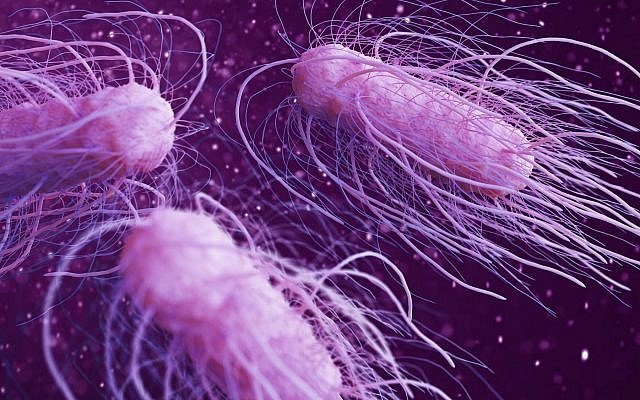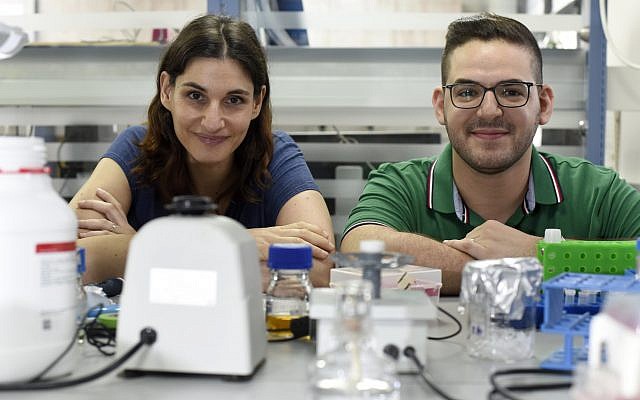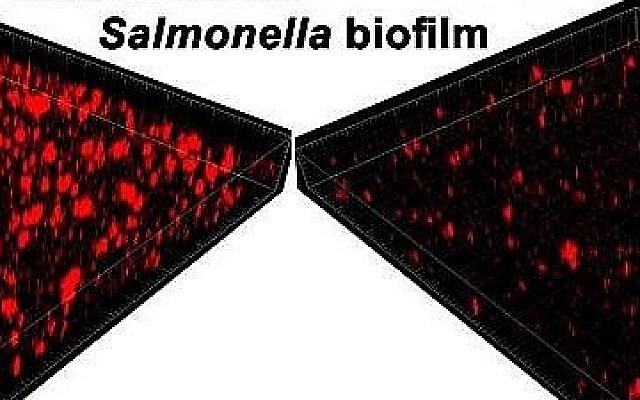
Technion team repurposes compounds originally developed to treat Alzheimer’s and manage, in lab, to inhibit the formation of bacteria-protecting biofilm
By SHOSHANNA SOLOMON
Biology researchers at Haifa’s Technion-Israel Institute of Technology say they may have found a way to make salmonella bacterial infections less aggressive by inhibiting the formation of biofilm, a layer of microorganisms that enables bacteria to attach to surfaces.
Biofilm is a resistant layer of microorganisms that form on and coat various surfaces. This layer constitutes a serious medical and environmental problem because it protects bacteria and enables them to attach to tissues, medical devices, pipes, skin and surfaces.
The scientists — associate professor Meytal Landau, doctoral student Nir Salinas, and the laboratory research team — now hope their discovery will lead to the development of new treatments to fight virulent infections, without creating antibiotic resistance, the Technion said in a statement.
“If you reduce biofilm, the bacteria becomes much less aggressive,” said Laudau in a phone interview. It is the biofilm that enables the bacteria to attach itself to surfaces, or skin or catheters, she said. “Less biofilm reduces the aggressiveness of the infection.”

Landau emphasized that the study was conducted only in vitro — or in a lab — and not on mice or in humans yet.
Salmonella is often linked with contaminated water or food. Most people infected with the bacteria develop diarrhea, fever, and abdominal cramps between 12 and 72 hours after infection, according to the US based Centers for Disease Control and Prevention. Most individuals recover without treatment after about a week, but if the infection spreads into the bloodstream, it can cause death unless the patient is treated immediately with antibiotics.
In their work, the researchers decided not to tackle the bacterium itself, but the biofilm – the resilient layer that protects bacteria from substances that pose a danger to them, including antibiotic drugs. This approach reduces the risk of the bacteria developing resistance, as often happens when bacteria are targeted by antibiotics, triggering defense mechanisms against the drug, and making the bacteria more resilient and virulent instead of weakening it.
In their study published in PLoS Pathogens, the Technion researchers, based on their previous research, decided to interfere with so called “amyloid fibrils” produced by the salmonella bacteria. These fibrils, it was found in previous studies, are able to attack the T cells of the immune systems. It is these fibrils that protect the bacteria and help them attach to things, Landau said.
These same fibrils are also found in other bacteria, like E coli or the staphylococcus aureus — an especially virulent bacterium that has become resistant to many types of antibiotics and that is responsible for a considerable number of infections in hospitals and in the community.
These toxic fibrils resemble amyloids, proteins associated with neurodegenerative diseases such as Alzheimer’s and Parkinson’s, but differ from them structurally, the Technion said.

Technion researchers tackle Salmonella by inhibiting the formation of biofilm. Three-dimensional images that show, left, high biofilm biomass and right, how the addition of a ANK6 compound leads to a significant decrease in the amount of biofilm (Courtesy)
So, for their work, the scientists decided to repurpose substances, or compounds, that have already undergone clinical trials for treating Alzheimer’s, to see if they could hamper the bacteria’s defense mechanisms and their ability to attach to tissues and medical devices. And they succeeded.
“When we added the compounds to the salmonella bacteria, it hindered the growth of the biomass, thus reducing the aggressiveness of the infection,” Landau said. “The compounds reduced the biofilm biomass.”
The major advantage of the repurposing of substances that are being used or were used in clinical trials for Alzheimer’s is that the approval process for them is much shorter and less expensive than in the case of a new compound, the researchers said.
Landau said she hoped the discovery will also be effective in battling the biofilm of other bacteria, thus weakening the bacteria itself, including staphylococcus aureus.
The research is being carried out in collaboration with the Institute for Complex Systems in Jülich and in Düsseldorf, Germany. The Technion Center for Structural Biology (TCSB), the Lorry Lokey Interdisciplinary Center for Life Sciences and Engineering, the Electron Microscopy Center, and the Center for Electron Microscopy of Soft Matter in the Russell Berrie Nanotechnology Institute (RBNI) also provided assistance for the project, the statement said.